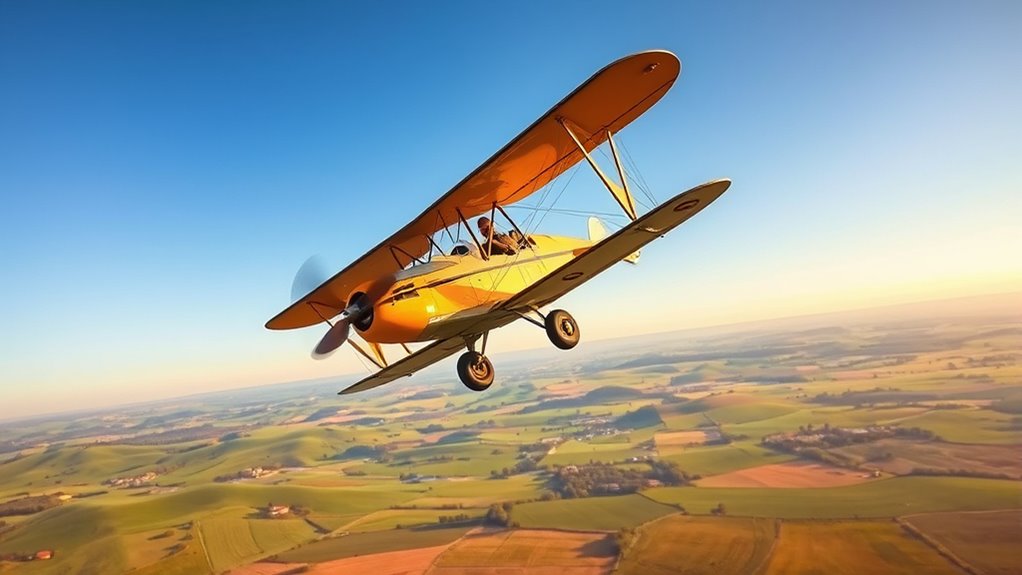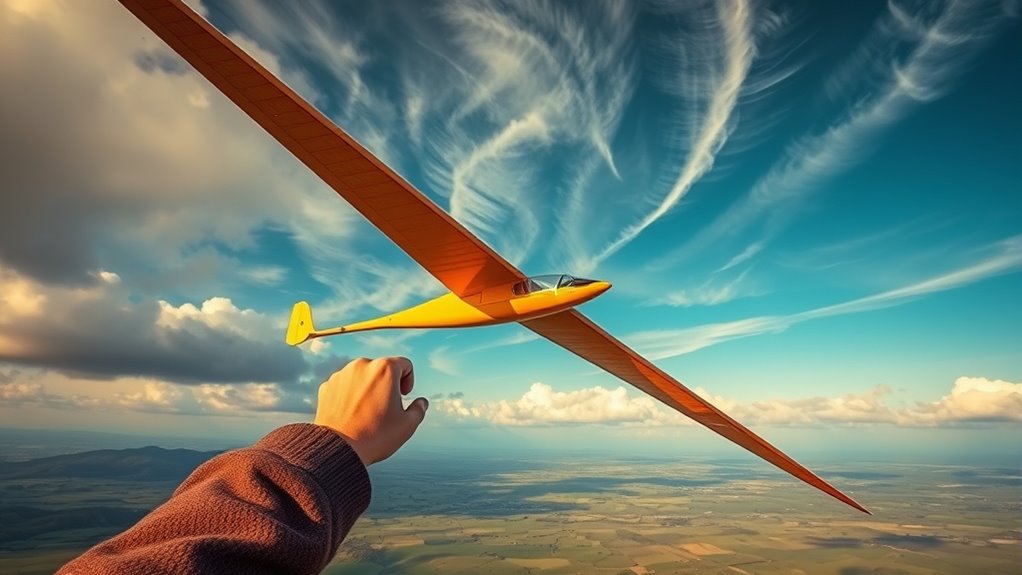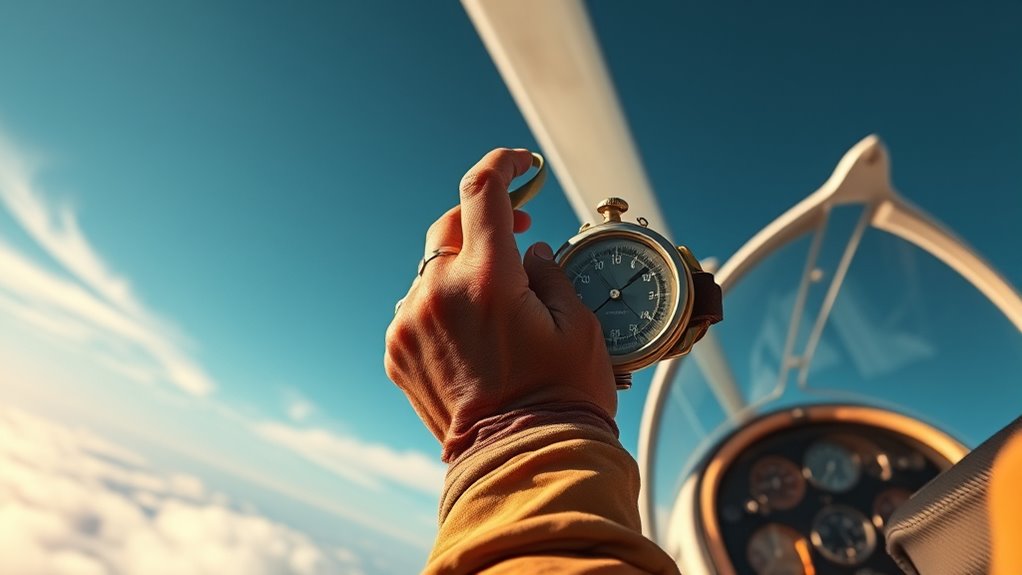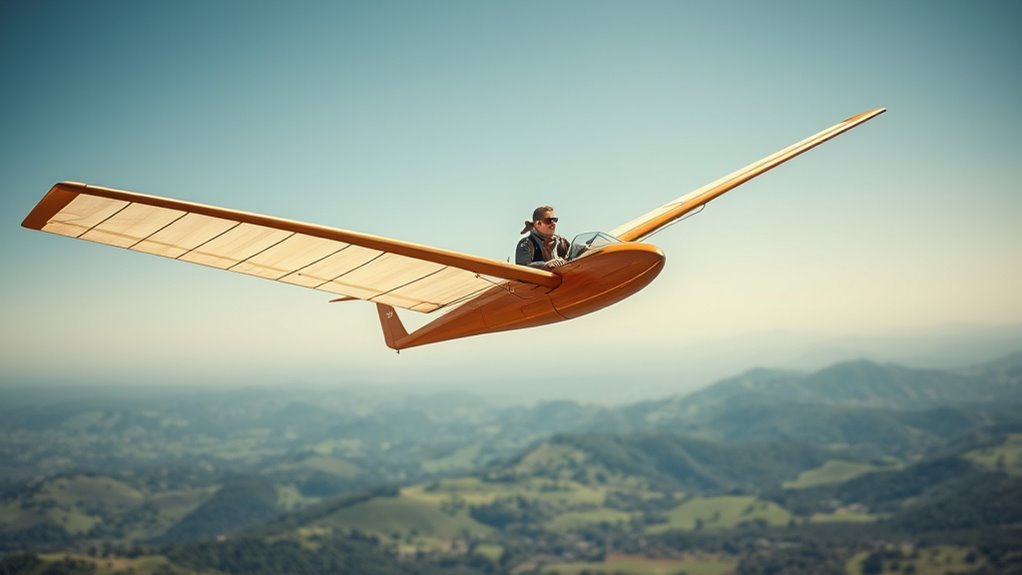Flying without a variometer means trusting your natural skills and environmental cues rather than relying on instruments. By observing cloud formations, bird activity, wind, and ground features, you can identify lift and sink intuitively. Developing a strong feel for the sky and sensing subtle changes in airflow enhances your awareness and safety. Embracing these old-school techniques restores your connection to traditional soaring, and if you keep exploring, you’ll deepen your understanding even further.
Key Takeaways
- Develop keen observational skills to interpret natural cues like cloud formations, bird behavior, and landscape features indicating lift or sink.
- Hone sensory awareness by feeling aircraft responses, air pressure changes, and wind sounds to detect thermal activity without instruments.
- Practice reading the sky and environmental signals to build intuition for lift, sink, and safe navigation during instrument failure.
- Combine traditional visual cues with modern technology to create a balanced, resilient flying approach.
- Revisit fundamental navigation and environmental awareness skills to ensure safety and confidence when flying without a variometer.
The Historical Roots of Soaring Navigation

Understanding the roots of soaring navigation reveals how pilots relied on natural cues long before modern instruments existed. Vintage navigation methods depended on keen observation and environmental clues. Pilots used historical techniques such as watching the sun, stars, and wind patterns to stay aloft and chart their course. They also paid close attention to the landscape—mountains, rivers, and cloud formations—to gauge their position and anticipate lift. These skills required sharp perception and experience, as pilots couldn’t rely on electronic aids. Instead, they developed a deep understanding of natural cues, which helped them navigate accurately during long flights. The practice of somatic therapy emphasizes similar awareness of bodily signals, underscoring the importance of intuition and perceptive observation in both disciplines. This tradition of vintage navigation forms the foundation for modern soaring, reminding us how resourceful pilots were before technology transformed the sport.
Recognizing Natural Lift Indicators

How can you tell when a thermal or lift is present during a flight? One key is observing natural lift indicators like smoke trails, cloud formation, or soaring birds. These cues signal rising air, helping you stay aloft without a variometer. To refine your skills, consider the following indicators:
| Indicator | Description | Tip |
|---|---|---|
| Circling birds | Birds circling upward suggest lift | Watch for raptors or gulls |
| Cloud bases | Rising cloud bases indicate thermal activity | Use weather prediction to anticipate lift |
| Turbulence | Slight bumps or smooth glides hint at lift | Maintain glider maintenance for safety |
| Soil features | Warm ground patches can cause thermals | Recognize patterns for better prediction |
Additionally, understanding thermal dynamics can improve your ability to detect lift effectively. Mastering these signals enhances your ability to find lift naturally, prolonging flight and honing old-school soaring skills.
Mastering Visual Cues for Ascent and Descent

By paying close attention to visual cues, you can effectively gauge whether your glider is ascending or descending. Aeronautical folklore emphasizes the importance of observing subtle signs like the movement of nearby clouds, the angle of the horizon, or the way the glider’s nose behaves. These cues develop your pilot intuition, allowing you to interpret the sky’s signals without instruments. For example, if you notice the clouds above start to thin or drift apart, you’re likely climbing. Conversely, a downward tilt of your nose or clouds gathering below can indicate descent. Trusting your eyes and understanding these visual indicators helps you make strategic decisions, maintain situational awareness, and stay connected to the sky’s natural rhythms—crucial skills when flying without a variometer. Regularly observing natural indicators can also improve your overall pore size awareness, enhancing your ability to interpret environmental cues effectively.
Developing a Feel for the Sky Through Sensory Awareness

Developing a feel for the sky relies on honing your sensory awareness and trusting your instincts as a pilot. Sensory calibration is key—you learn to interpret subtle cues from the wind, your aircraft’s response, and your body’s sensations. Pay close attention to changes in pressure on your hands, shifts in airflow, and the sound of the wind around you. Over time, these cues become intuitive, enabling instinctual flying without relying on instruments. This heightened awareness helps you judge lift and sink more accurately, making your flying more responsive and confident. Practice tuning into these sensations regularly, and you’ll develop a natural “feel” for the sky that guides your decisions—just as seasoned gliders do, even without a variometer. Understanding weather patterns and their effect on wind and lift can further enhance your sensory awareness and flying instincts.
Practical Techniques for Old-School Soaring

To soar effectively without a vario, you need to recognize lift and sink by paying close attention to your aircraft’s response. Use your airspeed and visual cues like cloud formations and terrain to guide your decisions. Mastering thermal circulation helps you stay aloft longer, even without electronic aids. Developing an understanding of gauge reading techniques can further improve your ability to detect subtle changes in lift and sink.
Recognizing Lift and Sink
Recognizing lift and sink relies on keen observation and subtle cues from your glider’s behavior. You must trust your senses and interpret changes in airspeed, attitude, and control feel. Proper instrument calibration guarantees your cockpit cues match reality, helping you detect slight variations that indicate rising or sinking air. Understanding the weather pattern is essential; knowing typical thermal locations or the influence of terrain helps predict where lift might occur. Pay attention to your glider’s pitch and bank, as smooth, sustained adjustments often signal consistent lift or sink. Without a variometer, reading these physical cues becomes critical. Practice observing your aircraft’s responses and correlating them with environmental clues, sharpening your old-school skills for safer, more intuitive soaring. Recognizing dog names can also help in establishing a familiar and comfortable environment during long flights.
Using Airspeed and Visual Cues
By observing your glider’s airspeed and visual cues, you can detect lift and sink without relying on instruments. A lower airspeed often signals rising air, especially if your wing loading is optimized; your glider may be gently accelerating in lift zones or slowing in sink. Watch cloud formations—cumulus clouds typically indicate thermals, while smooth, flat skies suggest sink. Pay attention to how your glider responds: if it feels lighter and climbs slightly, you’re in lift. Conversely, a quick decrease in airspeed and a tendency to sink suggest entering sink. Your wing loading influences sensitivity; lighter gliders respond more noticeably to subtle cues. Combining these visual signals with airspeed awareness helps you navigate lift and sink patterns confidently, even without a variometer.
Mastering Thermal Circulation
Mastering thermal circulation requires keen observation and timely maneuvers, especially when relying on old-school techniques. You’ll need to refine your altitude estimation skills by noting changes in the glider’s sound, sink rate, and visual clues like circling birds or cloud formations. To stay in the core of the thermal, you must compensate for wind drift by reading the ground and adjusting your heading accordingly. Recognize when your altitude stabilizes or increases, indicating you’re in rising air. Automation technologies can assist in tracking lift, but developing your observational skills is essential for self-reliance. Consistently observing these cues helps you stay in lift longer without a variometer. Practice subtle control inputs and develop a feel for the thermal’s behavior. With patience and sharp observation, you can master thermal circulation and extend your flight even without electronic aids.
Comparing Modern Instruments and Traditional Skills

Modern instruments, like electronic variometers and digital flight computers, provide pilots with real-time, precise data that can be difficult to interpret without training. They simplify navigation by offering detailed altitude and speed readings, reducing guesswork. However, relying solely on technology can lead you to overlook fundamental navigation skills and safety protocols that are essential when instruments fail or become unreliable. Traditional skills, such as reading the sky, understanding wind patterns, and using visual cues, remain indispensable. These skills foster a deeper connection with your environment, ensuring safety even without high-tech tools. Additionally, understanding the affiliate disclosures and privacy policies associated with modern devices can help pilots make informed decisions about data sharing and security. While modern devices enhance precision and ease, integrating them with time-tested techniques creates a balanced approach, making you a more versatile and confident pilot.
Embracing the Challenge: Benefits of Flying Without Technology

Flying without technology challenges you to rely on your instincts and fundamental skills, which can greatly enhance your overall piloting ability. Without modern instruments, you sharpen your pilot intuition, learning to interpret subtle cues from the aircraft and environment. This process reduces your reliance on equipment, forcing you to develop a deeper understanding of aerodynamics, weather, and your aircraft’s behavior. As you trust your senses more, your decision-making becomes more intuitive and responsive. Flying this way also builds confidence and resilience, making you more adaptable in unexpected situations. Embracing the challenge not only reconnects you with traditional flying skills but also improves your ability to navigate and react accurately, regardless of technology’s presence or absence. Additionally, practicing these skills can help you better assess your aircraft’s performance and environmental conditions, strengthening your overall flying proficiency.
Frequently Asked Questions
How Can I Safely Fly Without Modern Variometers?
To fly safely without modern variometers, rely on manual navigation skills and keen observation of visual cues. Focus on reading the sky, detecting changes in cloud formations, wind patterns, and terrain features to gauge your altitude and lift. Use your experience to interpret subtle signs of rising or sinking air, staying alert for shifts in weather. With practice, these traditional methods can keep you safe and confident during your flight.
What Are the Common Mistakes Beginners Make When Using Natural Cues?
Ever feel like you’re chasing shadows? Beginners often fall into the trap of cue overreliance, mistaking visual cues for true lift or sink. This leads to errors like misjudging thermals or misinterpreting the sky’s signals. They also fall prey to visual misinterpretation, ignoring subtle signs that require experience. To avoid this, stay alert, cross-check cues, and don’t depend solely on what you see—trust your instincts and learn from each flight.
Are There Specific Weather Conditions Best Suited for Old-School Soaring?
You’ll find that clear, moderate cloud cover and steady wind conditions are ideal for old-school soaring. These conditions help you spot lift sources and maintain control without relying on instruments. Light to moderate winds create predictable patterns, making it easier to sense thermal activity. Avoid extreme weather, such as stormy or very windy days, as they can obscure natural cues and make flying more challenging.
How Does Flying Without Technology Impact Flight Safety?
Ever wondered how flying without technology impacts your safety? Relying on manual navigation and weather interpretation, you sharpen your skills and become more aware of your environment. Without instruments, you must trust your instincts and knowledge, which can prevent surprises. This old-school approach encourages better decision-making, though it demands more focus and experience. Are you ready to embrace this challenge and enhance your flying safety through skill revival?
Can Traditional Skills Be Effectively Integrated With Modern Instruments?
You can effectively integrate traditional skills with modern instruments by balancing your reliance on technology with hands-on experience. While instruments boost safety and confidence, maintaining old-school skills enhances your overall flight proficiency. Developing a strong foundation in visual navigation and manual techniques guarantees you’re prepared for instrument failures. Combining both approaches creates a well-rounded pilot, improving safety and skill development, especially in challenging conditions where technology might not be enough.
Conclusion
By trusting your instincts and honing your natural cues, you *uncover* a deeper connection with the sky—one that technology can’t replicate. As you master these traditional skills, every lift and sink becomes more than just a moment in flight; it’s a story waiting to unfold. Will you rely solely on gadgets, or embrace the challenge of flying without them, discovering secrets only the old-school way can reveal? The sky’s mysteries await your next move.
With a heart that soars as high as the skies, Aria, affectionately known as “Skylark,” is the driving force behind Soaring Skyways. Her journey into the gliding world began as a young dreamer gazing up at the soaring birds, yearning to experience the weightlessness and freedom they embodied. With years of experience both in the cockpit and behind the scenes, Aria’s commitment to the gliding community is unwavering.









